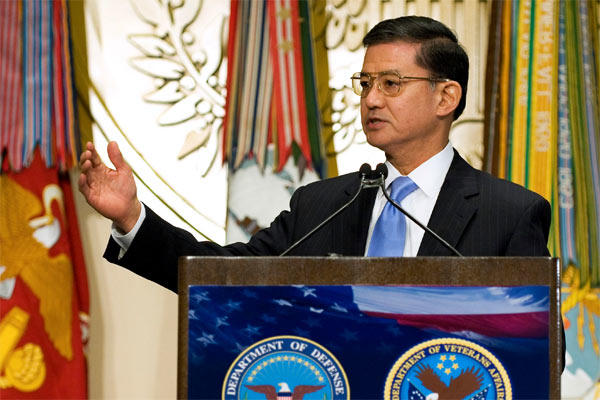The White House today demonstrated support for the Secretary of Veterans Affairs and his plan to deal with veterans' issues in the wake of a Time magazine column calling for his ouster and a veteran service organization's media blitz around disability claims backlogs.
"The president views this as national problem," White House chief of staff Denis McDonough said during a roundtable he hosted along with Secretary Shinseki for a number of national media organizations including Military.com at the Eisenhower Executive Office Building today. "Everyone with claims expertise – whether it's the IRS, HUD, HHS – is expected to support Rick [Secretary Shinseki] in the fight [to end the backlog]."
McDonough stated that the president's support of veterans is primarily manifest in his 2014 budget priorities that were just released, specifically the plus-up of the Veterans Benefits Administration funding to $2.5 billion, an increase of 13.6 percent. That increase is further broken down into $155 million earmarked for the migration to paperless claims, and $136 million for the agency's "veteran claims intake program."
The President's 2014 budget also includes funding to strengthen mental health care services and to incentivize employers to hire vets through a permanent tax credit.
In a Time magazine piece titled "A National Disgrace" that appeared in the March 25 issue columnist Joe Klein wrote ". . . [Shinseki] has been in office for four years, and the problems our veterans face are worse than ever – and about to get still worse as the military demobilizes tens of thousands of additional troops in the next few years. It is time for him to step down."
About when the Time column first appeared the Iraq and Afghanistan Veterans of America launched an "End the Backlog" campaign that included a claimed 160 meetings with lawmakers on the Hill, a sit-down with White House officials, and a number of national media appearances by Paul Rieckhoff, the organization's founder and executive director.
The result was both effective in generating attention and focus on the issues facing the VA and polarizing among the other VSOs in terms of opinions regarding Shinseki's tenure as secretary and the state of the VA in general.
But whatever the criticism, Shinseki said he is sticking to the plan that's underway, one he categorized in three parts: Provide greater access to the VA for all veterans, end the claims backlog, and end veteran homelessness.
Shinseki's strategy to improve access to all veterans is mostly manifest in his ruling in 2009 to add three new diseases to the VA's list of those compensable for Vietnam vets due to Agent Orange. In today's meeting the former Army chief of staff called that effort "unfinished business" on behalf of an earlier generation of warfighters, effort required in spite of the fact he knew it would worsen the backlog by 150,000 re-adjudicated claims and 100,000 new claims.
"You have to accept the fact you've increased the workload," Shinseki said.
The plan to end the backlog centers on the VA fully making the transition from paper to digital in the form of their Veterans Benefits Management System. Shinseki used an old artillery officer term – "splash point" – when identifying milestones for the implementation of VBMS saying that all 56 VA stations would have the system in place for processing claims by 2014 and that the backlog would be gone by 2015.
Shinseki pointed to the learning curve associated with the Post-9/11 GI Bill as an example of where the agency can show results with a migration from paper to digital. "When we first started the new GI Bill a few years ago we did all applications on paper and we had a backlog and we reduced it by going digital."
But while stating overarching support for Shinseki's plan and leadership of the agency, McDonough also said, "It's not only about the inputs, it's the outputs," meaning President Obama was keeping a close eye on the results.
As far as thoughts of complying with calls for his ouster, Shinseki seemed resolute.
"In this job I get to take care of kids I went to war with 40 years ago in a place called Vietnam," he said. "I get to take care of those kids we deployed when I was service chief. I get to take care of the great giants, those veterans of World War 2 who saved the world and those who saved a country in the ‘50s and who raised me in the profession. For those reasons, when the president offered me the opportunity I took it, and I haven't really thought much more about it."

























